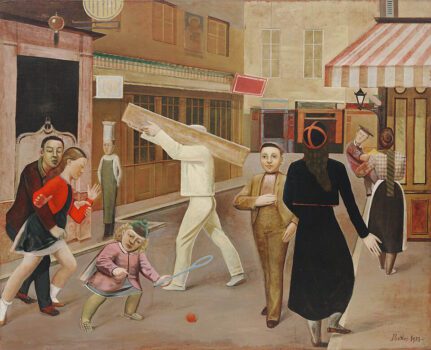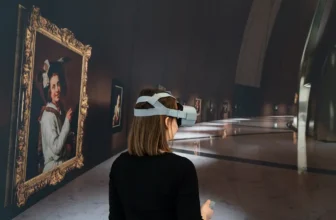What is The Meaning of The Street Painting by Balthus
Balthasar Klossowski, known mononymously as Balthus, was a unique and enigmatic figure in 20th-century art. Operating outside the mainstream movements of his time, Balthus cultivated a deeply personal visual language that often invited both admiration and controversy. One of his most iconic and thought-provoking works is The Street (original French title: La Rue), painted in 1933.
This large-scale painting (measuring approximately 254 x 300 cm) stands as a striking tableau of urban life filtered through the surreal lens of Balthus’ singular imagination. At first glance, The Street appears as a snapshot of a lively, bustling city scene. But upon closer inspection, it becomes evident that this painting is layered with symbolic depth, eerie stillness, and unsettling ambiguity. The figures, though engaged in seemingly ordinary activities, convey an unnatural detachment, as though caught in a dream, or a psychological freeze-frame.
In this article, we will explore The Street in depth: how it was painted, what it portrays, its artistic style, its symbolic and psychological layers, and where it resides today. Through an analytical lens, we will uncover how this painting challenges the viewer’s expectations and continues to provoke rich discussion nearly a century after its creation.
Visual Description of The Street
The Street depicts a group of people interacting, or more precisely, coexisting, on a Parisian street. The scene unfolds in what appears to be a narrow urban passage, flanked by tall buildings that create a canyon-like enclosure. A dozen or so figures populate the canvas, each engaged in disparate actions: a man is seen dragging a girl by the arm; a woman reaches up toward a window; a young boy holds a stick; another girl is standing motionless in a pose of vulnerability.
At a distance, this could resemble a typical street scene. However, Balthus’s rendering of the figures and their interactions is uncanny. The composition is theatrical and stiff. None of the characters interact with each other in meaningful ways; they appear frozen, marionette-like, or immersed in private rituals. Time seems suspended.
The color palette is subdued, with earthy browns, grays, and flesh tones dominating the canvas. The architectural background is stark and devoid of decoration. This detachment of background and foreground, coupled with exaggerated physical gestures, lends the painting a surreal, dreamlike quality. It’s a world that mimics reality but doesn’t quite belong to it.
The Creation of The Street
Balthus painted The Street in 1933, when he was just 25 years old. At the time, the Parisian art world was dominated by movements like Surrealism and Cubism, and yet Balthus remained defiantly classical in his technique, drawing on the traditions of the Renaissance and early modern European masters. He admired painters like Piero della Francesca, Nicolas Poussin, and Courbet, and integrated their compositional rigor and chiaroscuro into his own highly idiosyncratic style.
Balthus had studied under Pierre Bonnard and was influenced early on by the writings of Rainer Maria Rilke (who had a relationship with Balthus’ mother and was something of a mentor). His training in drawing and love of narrative structure positioned him to create paintings that echoed both classical art and modern psychoanalytic inquiry.
The Street was painted using oil on canvas, with meticulous draftsmanship underpinning its surreal tableau. Balthus often created multiple preparatory sketches and studies, and The Street was no exception. He viewed painting as a meditative and disciplined process. In constructing this scene, he borrowed elements from his own neighborhood in Montparnasse but abstracted them to a theatrical set-like composition.
What is Happening in The Street?
Trying to describe exactly what is happening in The Street leads to a paradox, it appears bustling, yet frozen; populated, yet eerily depersonalized. The characters are posed as though they are actors in a tableau vivant. They do not relate to each other in coherent social terms. Their actions range from playful to aggressive to inexplicably symbolic.
Key actions include:
A young man dragging a girl by the arm, an image that suggests violence.
A woman reaching up, possibly toward a window or to open a shutter, her action unclear but desperate.
A boy with a stick in mid-stride, pausing without apparent purpose.
A woman leaning forward, clutching something close to her body.
A man with a newspaper walking with exaggerated formality.
The juxtaposition of everyday motions with stilted, unnatural stillness creates a mood of unease. These aren’t just people caught in a moment, they’re frozen in roles that hint at psychological states, power dynamics, and unconscious tensions.
Balthus was deliberately ambiguous. There is no clear narrative, no unified emotional tone. The painting exists in a liminal space between realism and symbolism, between ordinary life and subconscious drama.
Symbolism and Psychological Interpretation
One of the most fertile grounds for analysis in The Street is its use of symbolism and its psychological undercurrents. Balthus was well aware of Freudian and Jungian theories, and his paintings often explored themes of sexuality, repression, and the uncanny.
Frozen Time and the Theater of Life
The figures resemble actors on a stage, each caught in a separate soliloquy. This theatricality, present in the stiff poses and the composition’s forced perspective, implies that life itself is performative. These are not real people; they are archetypes, each playing a role in the subconscious theater of the human condition.
Sexual Tension and Power Dynamics
Much of Balthus’ work, including The Street, has drawn criticism for its treatment of adolescent sexuality and ambiguous interactions. The most controversial figure in this painting is the girl being dragged by the arm. Her limp form and exposed knee are suggestive, and the gesture of the man appears both aggressive and ritualistic.
The power dynamics here, between adult and child, male and female, are disturbingly unresolved. Balthus often depicted adolescence as a phase of deep psychological turbulence, and he portrays it here as both vulnerable and dangerous. While this depiction has been rightly critiqued through a modern lens, it also invites deeper inquiry into the nature of desire, control, and social codes.
Alienation and Modern Life
Though set in a city, The Street offers no sense of community or connection. Each person is isolated within their own private action. This may reflect the alienation Balthus perceived in urban modernity, a world in which physical proximity does not ensure emotional or social cohesion. The painting becomes a metaphor for existential disconnection.
What Type of Art is The Street?
The Street defies easy categorization. It is realist in technique but surreal in execution. It sits uneasily between several artistic categories:
Magic Realism: Balthus’s world resembles ours but is infused with an eerie stillness and psychological depth that breaks from reality.
Symbolist Painting: Like the Symbolists of the late 19th century, Balthus invested his scenes with allegorical weight and dream logic.
Classical Modernism: Though not abstract, his work borrows compositional strategies from classical art and updates them with a modern psychological sensibility.
Balthus himself rejected the label of Surrealist, though the influence of the movement is unmistakable. Like de Chirico, another artist who profoundly affected him, Balthus created mysterious worlds governed by subconscious logic rather than physical laws.
Where is The The Street Painting Located Today
Today, The Street resides in the collection of the Museum of Modern Art (MoMA) in New York. It is part of their permanent collection and is periodically displayed in exhibitions dealing with 20th-century European art or themes of urban modernity and psychological painting.
MoMA acquired the painting in the mid-20th century, recognizing its significance in bridging classical technique with modern themes. Its large scale and visual ambiguity make it a centerpiece in any gallery space it inhabits.
Reception
When Balthus first exhibited The Street, reactions were mixed. Some critics lauded his technical skill and daring subject matter, while others found his treatment of youth and sexuality disturbing. Over the years, Balthus has remained a controversial figure. Feminist and post-colonial scholars have scrutinized his oeuvre, especially his fixation on the adolescent female form.
Nevertheless, The Street is widely regarded as one of Balthus’s masterpieces. It encapsulates the contradictions that make his work so powerful: beauty and discomfort, classical form and modern anxiety, narrative and stasis.
Contemporary artists and filmmakers have drawn inspiration from Balthus’s mise-en-scène. The eerie stillness and heightened theatricality in The Street can be seen echoed in the films of David Lynch and the paintings of Luc Tuymans.
What Is The Street All About?
The Street is not merely a depiction of a moment in urban life, it is a metaphysical painting masquerading as realism. Its true subject is not the street itself, but the invisible forces, psychological, sexual, symbolic, that animate human behavior. Each figure is a cipher, a stand-in for deeper emotional truths. The ambiguity of their actions and the distortion of time within the composition suggest that we are not witnessing real life, but rather a dream, or a psychological stage, where roles are acted out with unnerving precision.
By combining classical techniques with modern themes of alienation, sexuality, and subconscious impulse, Balthus created in The Street a timeless work that continues to provoke and inspire. It is a painting that resists simple answers and demands the viewer to look again, and again.




